Buying a mitre saw
Buying a mitre saw is a big decision in DIY terms, not only because of the price tag, but also whether you can justify that it will indeed be used enough to pay back that investment. The thing is, the name ‘mitre saw’ sort of suggests you only really need it to form perfect mitred, generally 45 degree, cuts. Yes, of course that is its major selling point, but just in terms of cutting lengths of timber quickly, ‘squarely’, and therefore accurately, a mitre saw is simply an invaluable piece of kit for DIY. Quite frankly, if there’s any tool that can make your work look better than it otherwise may have been, it must be the mitre saw. The following guide points out the differences between different models, as well as my recommendations for buying a mitre saw.
Mitre saw types
Part of choosing the right mitre saw for you, comes with knowing the terminology that differentiates between the different types of mitre saw.
Standard mitre saws
Standard mitre saws will go up and down, and allow you to rotate the saw body, above the cutting platform, to make mitred cuts. The blade is only ever in a vertical position. So if you need to cut a skirting board mitre, it is positioned upright below the saw, and you cut down through the height/depth of the board.
This is fine, but you are limited as to how large a piece of skirting you can cut i.e. slightly less than the radius of the blade.
Compound mitre saws
Compound mitre saws let you tilt the saw one way so that, for example, you can lay the piece of skirting flat and tilt the saw to allow you to make the cut.
In this way, you can make a longer mitred cut, in comparison to a standard mitre saw, as you can now cut skirting with a depth to slightly less than the diameter (rather than radius) of the blade. It is also much easier to lay mouldings such as skirting board flat on the cutting platform, rather than cutting straight down through its height.
Sliding compound mitre saws
A sliding function means that you can increase the length of a cut further as you can literally slide the saw backwards and forwards, and not just up and own.
Basically, this allows you to cut much wider lengths of timber than would be the case with a standard mitre saw or compound mitre saw. The sliding function therefore comes into its own with items such as wide floorboards, and ceiling joists.
Double bevel mitre saws
Double bevel mitre saws are a step on from compound saws as they tilt both ways, which basically provides greater ease of use.
For example, when cutting internal and external mitres for skirting boards, with a straightforward compound mitre saw, you’ll find yourself regularly picking up skirting lengths, flipping them over, and generally doing a lot more maneuvering in order to make the necessary cut. With a bevel mitre saw, there is no need for this maneuvering as the saw tilts both ways.
In conclusion, compound and sliding options basically give you greater functionality. Cut size capability, as well as cut limits are described in the details with any saw, so make sure you pay attention to these specifications before making a purchase. In brief, for me, being ‘compound’ is essential – ‘sliding’ is a luxury, but certainly worth it if it’s within your budget. Double bevel options are the ultimate in mitre saws, but good ones do come at an ultimate price!
So, are mitre saws really DIY?
If you do any sort of woodwork like fitting architrave and skirtings, laying wooden floors, laying decking, and knocking up the odd stud wall, then you’ll find a mitre saw an invaluable piece of DIY kit. These tools are simple to operate, but you must remember to stay safe  – and check the safety features the saw has. Read instructions carefully before use, as mitre saws do need serious respect. Price can certainly be an issue though as if anything makes your eyes bleed, it can be the price you have to pay for a top of the range mitre saw. However, it’s now possible to get well priced options that are both good brand names and excellent quality.
Which saw to buy?
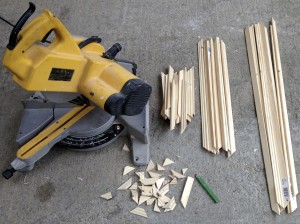
My DeWalt 707 after mitring lengths of decorative mouldings, very accurately. It was just as happy the next day chopping up lengths of 6in by 2in treated timber for a roof!
Call me overly safety conscious, but cheap mitre saws that look and feel like something given away on the back of corn flakes packets do scare me. Therefore, I would only recommend the big brands with any sort of power saw as I’ve owned, used, and tried a wide selection, quality will always reflect accuracy, and for the sake of a few pounds, it’s really not worth risking arms, fingers, and eyes.
The large Makita mitre saws (£500+) won’t be beaten on performance, but are only a requirement at the top end of DIY use.
For considerably less money, I’ve been using a DeWalt sliding compound mitre saw (shown above), for a few years now, and I have to say, it’s quiet (as far as mitre saws can be), accurate and smooth to use. You can now get updated versions of my saw, namely the DW777, with great prices to be found on Amazon, and it’s also worth checking out Screwfix.
However, for most DIY, it really isn’t necessary to look any further than the little Makita MLS100/2. It’s just an absolutely superb little compound mitre saw, that will deal with most DIY cutting requirements. Amazon normally have a number of suppliersfor the Makita, but again, places like Screwfix, and Wickes are also worth a look for a bit of a price check!
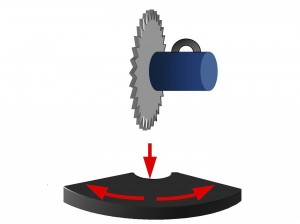
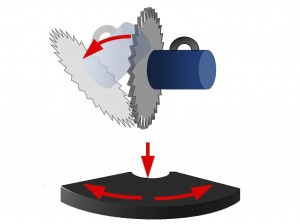
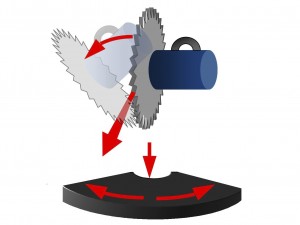
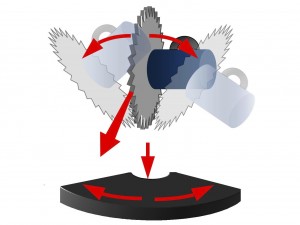

Hi Julian, just been reading your mitre saw reviews.I was given your diy book from santa a couple of years ago and it has been invaluable to me when doing my amatuer diy-ing!.
I have just about completed a back patio slab laying project( job and a half ! ) and I am now away to tackle the decking area so I thought I would treat myself to a mitre saw.I have purchased an Evolution Fury3 compound/sliding saw which was on offer at B&Q, got any thoughts on this tool? It did get good reviews on another site but I would appreciate your impartial opinion.
Although I like dabbling in diy I am a Toolmaker to trade so I am guilty of being maybe ‘too’ precise with my fits etc! but I like it when you stand back and can say..’yep,good job’.Thanks again.
Yours in diy
Kenny G
Hi Kenny,
Glad the book is helpful!
Regarding mitre saws, I think you’re very wise to have purchased one for your decking project – not essential but it will make your life so much easier. Having read my review, I think you will see where my preferences are, but in terms of choosing one of the less well-known names in the power tool world, I think you’ve made a wise decision. Evolution make ‘proper’ tools, and although this model is in their DIY range, I’m sure you will have the required accuracy there. The only limitation will probably be that it won’t stand up to heavy every day use, but this is clearly not going to be the case in your situation.
It is a well reviewed machine and I think that Evolution will be gaining a bit more of the market in the years to come. Therefore, I’m sure you’ll be fine, and I’d love to hear how you get on – feel free to post your own review here, telling us how you think the Evolution Fury 3 performs.
With very best wishes,
Julian